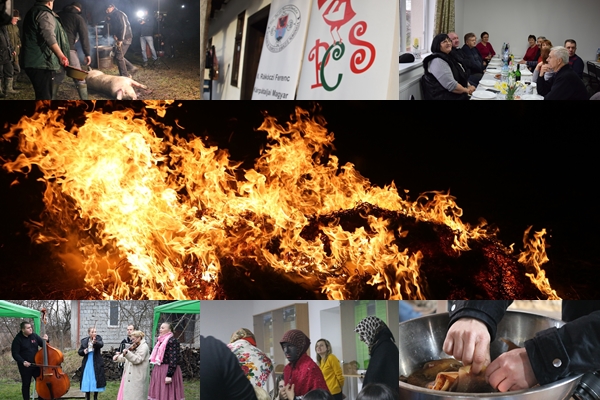Charity carnival pig slaughter feast in the Nagybereg Ethnographical Museum
Pig slaughtering has a long tradition in Hungarian culture. In the times of our ancestors, this was a significant event. On that day, the children of families didn’t even go to school so that they could participate in the auspicious occasion because the work and entertainment started at dawn for the entire family. Families took turns hosting pig slaughters so that they could help each other out.
We revived these traditions on February 9th when a charity carnival pig slaughter feast took place at the Nagybereg Ethnographical Museum, organized jointly by the Ferenc Rakoczi II Transcarpathian Hungarian College of Higher Education and the Pro Cultura Subcarpathica civil organization.
The participants were not even put off by the fact that they had to get up at the crack of dawn, as the day started early with the stabbing of the animals and scorching them with straw. In the meantime, a delicious breakfast was prepared in the kitchen of the Ethnographical Museum, with the help of the students of the Egán Ede Vocational Training Centre’s cookery course. From their hands came steamed stuffed cabbage and traditional onion with blood and kidney with marrow.
Breakfast was followed by the traditional processing of pork, which the guests were invited to join in. After the dismantling, the participants were also shown the process of cleaning the intestines, traditionally done with corn husk, soda and salt, and the mincing of meat for sausages, the spinning of rice and the melting of fat.
A delicious lunch of mashed potatoes and roast meat awaited those who had worked hard in the morning. In the afternoon, the traditional processing of pork meat followed. Those present could join in the process of making sausages and welt, salting, smoking and fat melting. Ildikó Orosz, president of our college, took an active part in all this.
The highlight of the day was the dinner, the pig pig slaughter feast, where the prepared sausages and welt were served. An essential part of a good pig slaughter is music, which was provided by the talents of the Kokas Banda.
It was typical in Nagybereg that during the pig slaughter dinner, carnival revelers would visit the house. At such times, men dressed as women, women dressed as men, and the elderly dressed as young people. When they arrived at the house of the pig slaughter, they peeked in through the window and rattled it. Once inside, they didn’t speak, just gestured. They gestured that they wanted wine and sausage. Finally, they invited the hosts into a short dance.
Meanwhile, there was a little trickery: 2-3 carnival revelers went to the side room to steal some welt from the pasteboard.
This tradition was revived to our great delight by the staff and students of the Tulipán Tanoda and the Páter Dobrai High School in Nagybereg.
With the pig slaughter feast, our college wanted to show that this tradition is still alive today, and many are happy to participate in it. The amount raised during the day will be used to help families connected with the Rákóczi College whose relatives are serving in the military on the front lines.
Anita Kurmay
-
This article is also available in
Magyar

